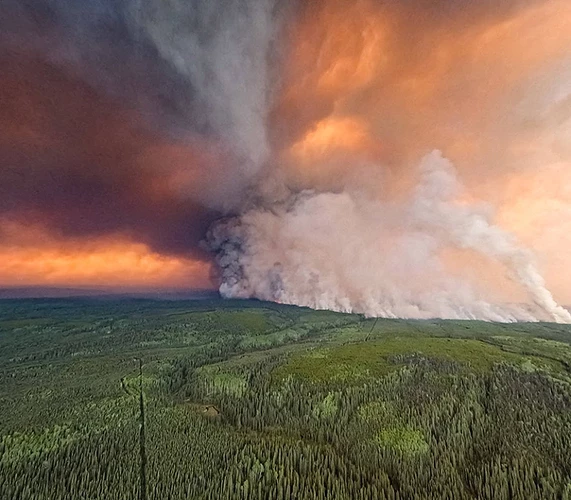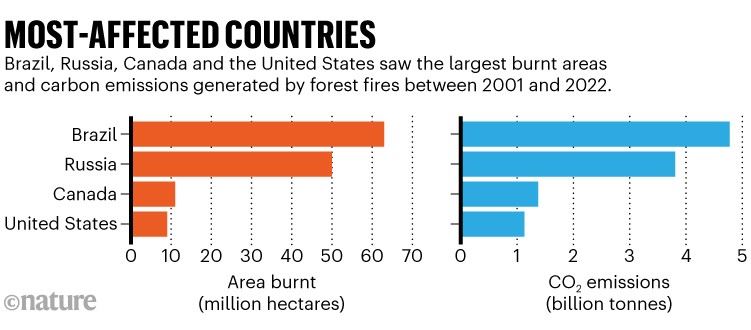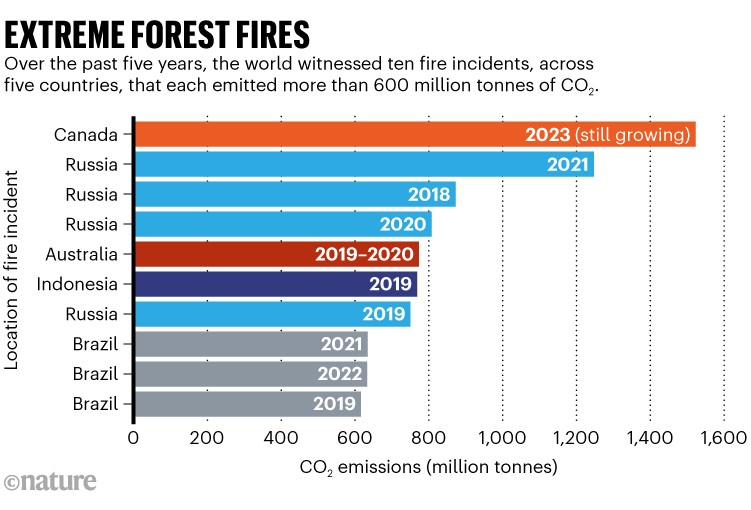Global forest fires emitted 33.9 billion tonnes of carbon dioxide (CO2) between 2001 and 2022, according to a report by the Chinese Academy of Sciences (CAS). This makes the CO2 emissions generated by forest fires each year higher than those from burning fossil fuels in Japan — the world’s sixth-largest CO2 emitter. Driving the emissions spike was the growing frequency of “extreme forest-fire events”.
Xu Wenru, a co-author and a landscape ecologist at the CAS Institute of Applied Ecology, based in Shenyang, China, says that the term ‘extreme forest fires’ generally refers to blazes that, compared with an average forest fire, burn through a larger area, last for a longer time and leave a bigger impact.
Xu and her colleagues found that the growth in emissions had been mostly fuelled by an uptick in infernos on the edge of rainforests between 5 and 20º S and in boreal forests above 45º N.
In particular, the emissions from boreal-forest blazes “showed a rapidly growing trend”, she says.
The increased numbers of forest fires was partially driven by the frequent heatwaves and droughts caused by climate change, Xu says. “In turn, the CO2 emitted by forest fires contributes to global warming, creating a feedback loop between the two.”
Humans also played a part. “Many forest fires were actually caused by humans when they were, for example, building fires to get warm at night, lighting fireworks or discarding cigarette butts,” says Xu.
Zhou Tianjun, a meteorologist at the CAS’s Institute of Atmospheric Physics in Beijing, found the report shocking. In particular, he points to a figure showing that, on average, the area of forest burnt by fires between 2001 and 2022 was 11 times the size of the forests planted by humans during that period.
“Tree plantation has been regarded as an important way to increase carbon sinks, but this figure shows that humans’ efforts could be offset by natural forest fires,” he says.
Source: Chinese Academy of Sciences
Record-breaking fires
The report singles out ten extreme forest-fire incidents that occurred between 2018 and 2023, each of which sent more than 600 million tonnes of CO2 into the air (see ‘Most-affected countries’). They were concentrated in five countries, all of which have vast forests: Russia, Brazil, Canada, Australia and Indonesia.
Topping the emissions list is this year’s record-breaking conflagration that ripped through Canada, home to 28% of the world’s boreal forests. In 2023, more than 6,700 fires have broken out across the country, burning through a total of 18.5 million hectares, almost half the size of Norway.
The CAS report found that the forest fires in Canada this year had emitted more than 1.5 billion tonnes of CO2 as of October (see ‘Extreme forest fires’), surpassing the emissions from all forest fires in the country over the previous 22 years combined.
Source: Chinese Academy of Sciences
The effects of forest fires and other types of wildfire are expected to worsen across the world in the decades to come.
Wang Yuhang, an atmospheric scientist and professor at the Georgia Institute of Technology in Atlanta, says the report complements his work1 which “indicates a roughly 20% rise in global burnt area by the 2050s compared to the 2000s”.
“More surprisingly, global fire carbon emissions are expected to double, highlighting the emergence of fire as a more significant carbon source at short-term timescales in the future,” Wang adds.
Wang echoes the report’s suggestion that countries should include carbon emissions from forest fires into their national climate plans and set up a monitoring, reporting and verification system for such emissions.
Given the scale of emissions that they generate, forest fires have become a source of CO2 emissions that “cannot be ignored”, Xu says.


